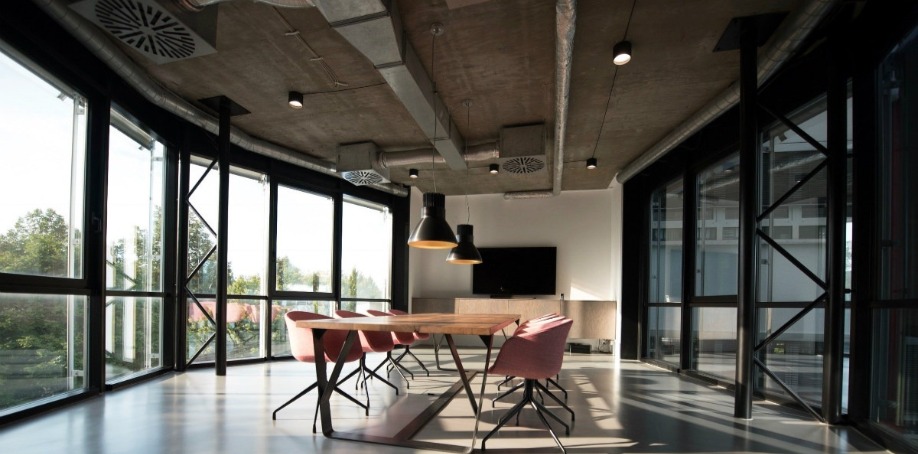
All over the internet, you can find captivating photos of the modern offices at companies like Google and Apple. Those high-tech spares are a dream for employees who are sick of being stuck in a cubicle all day.
But these top companies aren't the only ones that are investing in technology to make their employees more productive. “From our home office to the conference room, the way we work is changing at a rapid pace,” the team at Neurilink writes. “Many workplaces are encouraging their staff to work remotely, and are searching for ways to partner more closely with companies in other cities and countries. This means greater productivity and higher profits.”
Office designer who don't factor tech like pro AV into their office designs run the risk of alienating new employees and hampering the productivity of current employees. Further, they are likely to fall behind their competitors who are embracing tools like pro AV.
The stats back this up. The corporate market continues to account for the largest segment of pro-AV revenue, according to AVIXA's Industry Outlook Trends and Analysis (IOTA).
“If you look at the boardroom, conference room or even the office corridor, companies are increasingly using AV technology to bring more efficiency to their business,” notes Ramesh Jayaraman, vice president and general manager for HARMAN Professional Solutions.
But not all pro AV is created the same. You owe it to your employees and customers to invest in the tech that works the best for them.
What Employees Expect
“If you don't create a corporate office design that's tech-savvy, people won't use it,” says Kay Sargent, senior principal and director of workforce at HOK.
For this reason, user experience is a big consideration when building an office space. You need to consider what your employees will actually use, what types of things might confuse or slow them down, and how to train new employees on the technology quickly and effectively.
AVIXA staff instructor Marcus Yarborough also notes that you need to consider whom the technology's user is interacting with as much as the user themselves. For example, if you're using a pro AV display for a presentation, it isn't enough that the person presenting can do so easily. The people watching the presentation also need to be engaged and entertained.
“The user isn't just the presenter,” says Yarborough. “It's all the people in the space.”
Alinda Quinn at MarketScale notes that you should also take into account the age range of your employees. “Necessity has remained the mother of invention, and millennials' works needs are different from those of Gen X,” Quinn writes. “These needs are impacting office design, and AV companies are creating products to meet the expectations of current and future workers.”
Tools like AV over IP are precisely what modern offices need. Networked AV helps ensure all your current and future audio and video are interoperable. Because the AV data travels along internet connections, inputs and outputs can work with one another and be managed easily.

Modern Offices Accommodate All Modes of Productivity
The right AV installation can take your office from good to great. This edge is why more businesses than ever are building offices specifically with pro AV designed into them.
For example, Zoe Mutter discusses how WeWork uses AV to improve productivity. “Downstairs in the main lounge a sub-based AV system is controlled via an iPad with WeWork software overlaid, allowing members to add roaming mics, VC and change background music,” she writes. “As not everyone is productive in environments in which music is playing WeWork offices offer silent working spaces too.”
Building this kind of flexibility into the office design accommodates a wide range of personal working styles. The key is that pro AV is factored into the design itself, not integrated as an afterthought. This is how companies like Google and Apple design their workspaces.
Pro AV Facilitates Collaborative Work
Pro AV shines when teams need to conference. And conferencing — or simply collaborative work in general — is becoming a bigger focus for companies. "Even offices that don't have cubicle-free open floor plans are shifting their cultures to be more collaborative, and a new generation of specifiers are designing spaces and meeting rooms with moveable furniture and integrated AV equipment for maximum configurability,” Commercial Integrator notes.
Modern offices all over are turning to pro AV to manage their meetings. Even for buildings that aren't created with pro AV in mind anywhere else, it often plays a big role in conferencing.
This is in part because of the rise of remote workers and long-distance clients. As Align notes: “An AV-integrated technology infrastructure provides the framework for better communication inside and outside of your office space. Video conferencing capabilities allow for remote meetings and collaboration, accommodating employees and teams at separate locations for a truly company-wide means of communication.”
A Boon for Smaller Businesses, Too
Even for small businesses, pro AV can help with client retention and business growth. If clients know that they don't necessarily have to drive to your office to meet with you face-to-face, they can be much more willing to work with you.
That's why your conference room is one place where you don't want to ignore AV. As AV Magazine notes, “If conference rooms are not up to date with all of the latest technologies, chances are companies will struggle to host valuable, engaging and efficient meetings.”

Things to Consider When Upgrading Your Office AV
"Unlike life safety systems, which must meet codes and regulations when choosing device locations, there is no cookie-cutter approach when it comes to installing an A/V system,” says Steve Knese at Tech Electronics. “Every facility has unique architectural and acoustic properties, which must be considered in the planning process.”
This can seem overwhelming for someone who's been put, ad hoc, in charge of an office redesign. But the right AV integrator will work with you, as Data Projections instructs. “Every business or school has a unique set of needs that shouldn't be approached in an amateur fashion. By taking those needs and the specifics of the office space provided, an integrator can design and customize a suite of solutions that meets those needs on the given budget.”
Still, a little preliminary research into pro AV solutions can go a long way to making that collaboration successful. Charles McLellan at ZDNet, for example, warns against letting technology come before your people. “The fact is that the design and management of workplaces has a profound effect on the productivity, creativity and engagement of those who work in them,” he writes. Companies that design first then seek employee input later tend to see higher staff turnover.
The important thing, as Mechdyne notes, is your new tech needs to be user-friendly. “To be successful in a new building, all users must be confident with a simple, seamless, and consistent audiovisual and information technology (AV & IT) design that matches the company's workflow and the building's architecture.”
This above all else is why more and more businesses are turning to networked AV, and why more integrators are offering it. Because networked AV is flexible, it can seamlessly integrate into most companies' workflows. What's more, its infrastructure can scale with businesses as they grow.
Always remember: When you're building modern offices, you're planning for the long-term. So, create a pro AV plan that can grow with you.
Images by: Campaign Creators, Brooke Cagle, Nastuh Abootalebi


